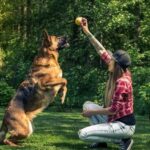Have you ever wondered how to train your dog to self-feed? Teaching your furry friend this skill can provide numerous benefits for both you and your pet. By allowing your dog to self-feed, you can establish a routine that promotes independence, reduces mealtime stress, and encourages healthy eating habits. In this article, we will explore the concept of self-feeding for dogs and provide you with helpful tips on how to successfully train your dog to feed themselves.
Self-feeding for dogs involves teaching your canine companion to regulate their own food intake without the need for constant supervision or intervention. This training method not only fosters a sense of responsibility in your dog but also helps prevent overeating and obesity. With the right approach and patience, you can empower your dog to make better choices when it comes to their meals while promoting mental stimulation during feeding time.
When embarking on training your dog to self-feed, it is essential to choose the right feeding system that suits both your pet’s needs and lifestyle. Whether you opt for an automatic feeder or a puzzle toy designed for meal dispensing, selecting the appropriate tools can make a significant difference in how effectively your dog learns this skill.
In the following sections, we will delve into setting up the feeding area for your dog, teaching them the concept of self-feeding, monitoring their progress, and addressing common challenges that may arise during training. Stay tuned as we guide you through the process of helping your dog become more independent at mealtimes.
Understanding the Concept of Self-Feeding for Dogs
Benefits of Self-Feeding
Self-feeding is a concept that allows your dog to have access to food at all times, promoting a sense of independence and control over their eating habits. This can be particularly beneficial for busy pet owners or dogs with specific dietary needs. By teaching your dog to self-feed, you can ensure they are getting the right amount of food throughout the day without having to stick to strict feeding schedules.
How Self-Feeding Works
The idea behind self-feeding is to provide your dog with access to food in a controlled manner. This can be achieved through various feeding systems such as gravity feeders, automatic feeders, or puzzle feeders. These systems dispense food as your dog eats or when they interact with the feeder, allowing them to regulate their own intake based on their hunger levels.
Training Your Dog
To train your dog to self-feed, start by introducing them to the feeding system gradually. Show them how the feeder works and encourage them to interact with it. You can use treats or rewards to reinforce positive behavior when they engage with the feeder and eat from it.
Consistency is key in training your dog to self-feed, so be patient and provide plenty of encouragement throughout the process. With time and practice, most dogs can learn how to self-regulate their feeding independently.
By understanding the concept of self-feeding and following a structured training process, you can successfully teach your dog to self-feed. This method not only promotes healthier eating habits but also gives your furry friend more autonomy over their meal times. With patience, consistency, and positive reinforcement, you can enjoy the benefits of self-feeding with your canine companion.
Choosing the Right Feeding System for Self-Feeding
When it comes to training your dog to self-feed, selecting the appropriate feeding system is crucial. There are different options available in the market, such as automatic feeders, puzzle feeders, and slow feeder bowls. Each type has its own benefits and considerations, so choosing the right one for your furry friend is essential to ensure successful self-feeding training.
Automatic feeders are a popular choice for pet owners who want to regulate their dog’s meal times and portion control. This type of feeder can dispense food at set intervals throughout the day, which can be helpful if you’re away from home for extended periods.
Puzzle feeders, on the other hand, encourage dogs to work for their food by solving puzzles or challenges to access their meals. This not only stimulates their minds but also slows down their eating pace.
Another option is a slow feeder bowl, designed with obstacles or ridges that make it more challenging for dogs to gulp down their food quickly. This helps prevent issues like bloat or obesity while promoting healthier eating habits. Consider your dog’s size, breed, eating habits, and any specific dietary needs when deciding on the right feeding system for self-feeding training.
| Feeding System | Key Features |
|---|---|
| Automatic Feeder | Regulates meal times and portion control |
| Puzzle Feeder | Encourages mental stimulation and slower eating pace |
| Slow Feeder Bowl | Prevents gulping and promotes healthier eating habits |
Remember that each dog is unique, so you may need to try out different feeding systems to see which one works best for your furry companion. By choosing the right feeding system tailored to your dog’s needs and behavior, you’ll set them up for success in learning how to train your dog to self-feed effectively.
Setting Up the Feeding Area for Your Dog
When training your dog to self-feed, setting up the feeding area plays a crucial role in the success of the training. Here are some essential steps to take when creating the perfect environment for your furry friend:
- Choose a designated spot: Select a quiet area in your home where your dog feels comfortable and safe. This could be a corner in the kitchen or a specific room where there are minimal distractions.
- Invest in the right feeding equipment: To facilitate self-feeding, consider using an automatic feeder or puzzle feeder that dispenses food at scheduled times or requires your dog to work for their meal.
- Provide easy access to water: Along with food, make sure your dog has constant access to fresh water. Place a water bowl close to the feeding area so they can hydrate themselves whenever needed.
Creating a consistent and inviting feeding environment will help establish a routine for your dog and encourage them to self-feed effectively. Remember, dogs thrive on structure and predictability, so maintaining a set location and setup for their meals is key to their success.
Moreover, keeping the feeding area clean and organized is essential for both hygiene reasons and your dog’s comfort. Regularly clean food bowls, feeders, and any surrounding areas to prevent bacteria buildup and ensure that your dog enjoys their meals in a tidy space.
Teaching Your Dog the Concept of Self-Feeding
Training your dog to self-feed can provide many benefits, including promoting independence, reducing anxiety around mealtime, and helping with weight management. To successfully teach your dog how to self-feed, it is important to understand the concept and implement the right training techniques.
The first step in teaching your dog to self-feed is to select the appropriate feeding system that best fits your dog’s needs. Automatic feeders, puzzle feeders, and slow feeders are some options to consider. These systems can help stimulate mental activity, slow down fast eaters, and promote portion control.
Once you have chosen the feeding system, you can start setting up the feeding area for your dog. Find a quiet and calm space where your dog can eat without distractions. It’s important to create a routine around mealtime so that your dog knows when to expect food.
Gradually introduce the new feeding system by placing small amounts of food in it and allowing your dog to explore and experiment with it. Be patient and use positive reinforcement techniques such as praise or treats when your dog engages with the feeder. Over time, increase the amount of food in the feeder as your dog becomes more comfortable with self-feeding.
Consistency is key when teaching your dog to self-feed. Monitor your dog’s progress closely and make any necessary adjustments to ensure that they are eating well and maintaining a healthy weight. If you encounter any issues during training, refer back to the troubleshooting section for guidance on how to overcome common challenges.
By following these steps and incorporating tips for successful self-feeding training, you can help your dog learn this valuable skill and enjoy the benefits that come with it. Remember that every dog is unique, so be patient and tailor the training process to suit your furry friend’s individual needs. With dedication and persistence, you can successfully train your dog to self-feed while strengthening your bond along the way.
Monitoring Your Dog’s Progress and Making Adjustments
Tracking Your Dog’s Progress
Monitoring your dog’s progress is crucial when training them to self-feed. Keep an eye on how much food they are consuming and if they are adjusting well to the new feeding routine. You can do this by checking their weight regularly and observing any changes in their behavior during meal times. If you notice any issues, be prepared to make adjustments to ensure that your dog is getting the right amount of food.
Adjusting Portion Sizes
As you continue with the self-feeding training, you may need to make adjustments to the portion sizes based on your dog’s needs. If your dog is losing or gaining weight unexpectedly, it could be a sign that the portion sizes need to be modified. Consult with your veterinarian if you’re unsure about how much food your dog should be eating and make necessary changes accordingly.
Addressing Behavioral Changes
During the training process, pay attention to any behavioral changes in your dog that may indicate they are struggling with self-feeding. Some dogs may become possessive over their food or show signs of anxiety around meal times. In such cases, it’s important to address these issues promptly by seeking guidance from a professional trainer or behaviorist. By addressing these challenges early on, you can help your dog adjust to self-feeding effectively.
Troubleshooting Common Issues in Self-Feeding Training
When you’re training your dog to self-feed, it’s common to encounter some issues along the way. However, with patience and consistency, these challenges can be overcome. Here are some common issues that may arise during self-feeding training, along with tips on how to troubleshoot them:
- Lack of Interest: Some dogs may initially show little interest in self-feeding. To address this issue, try making the feeding area more appealing by adding some of your dog’s favorite toys or treats nearby.
- Overeating: If your dog tends to overeat when given access to food at all times, consider using a timed feeding system instead. This will help regulate your dog’s food intake and prevent obesity.
- Food Aggression: In multi-dog households, food aggression can be a concern during self-feeding training. To prevent conflicts, create separate feeding areas for each dog and closely monitor their interactions during meal times.
It’s important to remember that every dog is unique, so what works for one may not work for another when it comes to self-feeding training. Be patient and willing to adjust your approach as needed to find the right solution for your furry friend.
- Slow Progress: If your dog is taking longer than expected to grasp the concept of self-feeding, break down the training into smaller steps and reward each successful milestone along the way.
- Messy Eating Habits: Some dogs may make a mess while trying to self-feed. Consider using a spill-proof bowl or placing a mat under the feeding area to contain any spills and make cleanup easier.
By addressing these common issues proactively and implementing appropriate solutions, you can help ensure a smooth transition for your dog into self-feeding habits. Remember that consistency and positive reinforcement are key components in successfully training your dog to self-feed.
Tips for Successful Self-Feeding Training
Training your dog to self-feed can be a rewarding experience for both you and your furry companion. To ensure success in this training process, here are some tips to keep in mind:
Firstly, consistency is key when it comes to training your dog to self-feed. Establish a routine and stick to it, whether it’s the timing of meal times or the location of the feeding area. Dogs thrive on predictability, so maintaining a consistent schedule will help them understand and adapt to the concept of self-feeding.
Additionally, patience is paramount when teaching your dog how to self-feed. It may take some time for your four-legged friend to grasp the idea of eating on their own without relying on you for assistance. Be patient with them as they learn and celebrate small victories along the way.
Another essential tip for successful self-feeding training is positive reinforcement. Praise and reward your dog whenever they make progress or successfully self-feed. This will motivate them to continue practicing this behavior and strengthen the bond between you and your pet. Remember, every dog is unique, so tailor your training approach to suit their individual needs and preferences.
By following these tips and staying committed to the process, you can effectively train your dog to self-feed. With patience, consistency, and positive reinforcement, you’ll soon have a well-trained pup who can independently enjoy their meals without constant supervision or assistance.
Conclusion
In conclusion, training your dog to self-feed can bring numerous benefits for both you and your furry companion. Not only does it promote independence and mental stimulation for your dog, but it also allows for a more structured feeding routine that can be convenient for busy pet owners. By understanding the concept of self-feeding and choosing the right feeding system, you can set up a successful self-feeding routine for your dog.
When setting up the feeding area for your dog, make sure to create a designated space that is easily accessible and comfortable for them to enjoy their meals. Introducing the concept of self-feeding to your dog may take some time and patience, but with consistency and positive reinforcement, they will eventually learn to feed themselves independently.
Remember to monitor their progress closely and make any necessary adjustments along the way to ensure they are adapting well to this new routine.
For those considering how to train your dog to self-feed, remember that each dog is unique and may require different approaches. Some common troubleshooting issues may arise, such as food guarding or overeating, but with time and effort, these challenges can be overcome.
By following the tips provided in this guide and staying patient throughout the training process, you can successfully teach your dog to self-feed and enjoy the benefits of this convenient feeding method. Give it a try and see how it positively impacts both you and your beloved pet.
Frequently Asked Questions
How Do I Train My Dog to Eat His Own Food?
Consistency is key when training your dog to eat his own food. Start by establishing set meal times and leave the food out for a set amount of time before removing it. Avoid giving in to begging or feeding scraps from your own plate.
How Do I Teach My Dog to Self Regulate Food?
Teaching your dog to self-regulate food involves providing the right portion size for his breed, size, and age. Measure out the appropriate amount of food each day and divide it into meals. Avoid leaving food out all day – stick to scheduled feeding times.
How Do I Get My Dog to Eat by Himself?
Encouraging your dog to eat by himself can be achieved by creating a routine around meal times. Make sure he is hungry before offering his food, feed him in a quiet area away from distractions, and give him enough time to finish his meal without rushing him.

Welcome to the blog! I am a professional dog trainer and have been working with dogs for many years. In this blog, I will be discussing various topics related to dog training, including tips, tricks, and advice. I hope you find this information helpful and informative. Thanks for reading!





